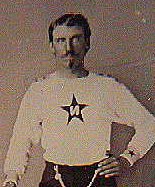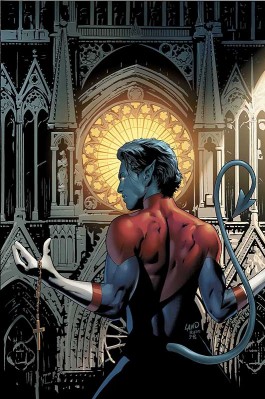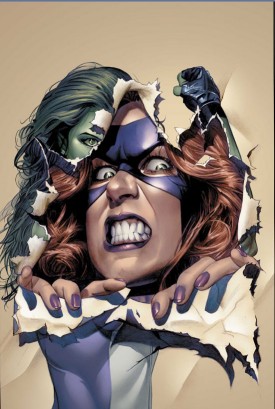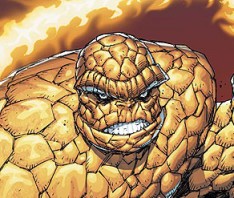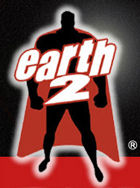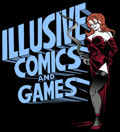|
|
|
|
Jason
Schachat was raised thinking a gypsy was his mother.
|
Jason
Schachat's Independent Breakdown
December 17, 2004
Each
week, Jason Schachat takes you along for his ride on the
four-colored pulp pony. Feed the addiction, and the addiction
feeds you.
Orson
Scott Card is writing Ultimate Iron Man, eh?
Maybe the Mormons
really ARE taking over.
I guess this
explains Derek’s five-year exclusive Marvel contract…
And,
while I poke fun at my esteemed editor, let’s talk
about how he pointed out in his Spotlight that Angeltown
felt a bit… odd… being a Vertigo book with no
supernatural horror in it (Bah! Someone must not be reading
Human Target, 100 Bullets, or The Losers;
half the Vertigo regular titles.) But I can see his point:
most Vertigo detective stories have some twist to them.
They’re set in the future, star vampires, involve
aliens, or have something to do with mystical forces. Angeltown
has none of these. And I really wish it did.
Angeltown
#2 is more of the same wannabe-noir we got
in the beginning. An O.J. Simpson/Kobe Bryant amalgam is
on the run from the law, following his ex-wife’s murder,
and it’s up to private dick Nate Hollis to find him
and learn what he was up to before things go from bad to
worse.
Nate gets a visit
from the obligatory evil bookie our sports superstar supposedly
owes money, but he beats the bookie’s goons up in
a very macho and intimidating way. Meanwhile, the newspaper
editor he’s boinking gets one of her crack reporters
on the story with information she’s squeezed (both
literally and figuratively) out of Nate. Nate’s high-priced
lawyer continues to be sneaky and dodge his questions about
what’s really going on, but that will probably change
after the bombshell that’s dropped at the end of the
issue.
If there’s
one glaring flaw in L.A. detective stories, it’s that
they’re too much like the city itself: flashy, exciting,
and giving an illusion of importance while having no substance
or complexity beyond the surface. L.A. is about illusion,
and, thus, is a hard city to know. New York and Chicago
have prided themselves on being more “upfront”
than the City of Angels, but the fact of the matter is L.A.’s
full of people trying to please people. It’s a cipher.
It’s whatever it has to be.
Angeltown,
however, isn’t so hard to pin down. It rips off the
work of Mickey Spillane on a superficial level and fills
the rest of the pages with attempts to be “street”
and weave a larger story. But it isn’t coming together.
Only the end of this issue made me curious as to who killed
the ex-wife. And, still, it has to be a red herring to come
out this early in the series.
Otherwise,
they played the card too soon, and we’re left to wonder
how the series might have worked better with demonic interventions
or monkeys wearing jetpacks. If you want a good detective-styled
story that uses the many faces of L.A. as a theme, check
out Human Target. If you want to spend a few bucks
watching modern characters use stilted dialogue in an attempt
to be old school noir… No, even then, pass on Angeltown.
I was
just as ready to pass on Nightcrawler when it first
came out. The character’s always been one of my favorite
X-Men, but let’s be honest; nobody knows how to write
for him. Given that Roberto Aguirre-Sacasa was the chosen
scribe, my hopes didn’t get high, even though Darick
Robertson was on art duties (still gotta collect those last
few issues of Transmetropolitan…). So, three
issues in, how’s the book progressed? Not too shabbily.
|
|
|
'Cuz
you gotta have faith...
|
No,
Nightcrawler #3 doesn’t
really blow me away, but the story rings true to the character
as he struggles to uncover the mystery of some disturbing
child murders. Nightcrawler first takes a quick break for
some fencing then has a heart-to-heart with Storm before
returning to his investigation of the one boy to survive
a seemingly demonic attack on a group of hospitalized children.
The little Haley
Joel Osment clone gets ready to leave his institutionalized
setting with the creepy Aunt (who conveniently turned up
when Nightcrawler’s investigation dug too deep). But
then aunty suddenly wigs out and attacks the even creepier
Dr. Childs on the sidewalk, clawing at his eyes and screaming
for him to undo a magical circle binding them together that
prevents Nightcrawler from interfering. Good thing he can
teleport, eh?
There’s
still a lot of murky storytelling here, and Robertson hasn’t
quite settled into his handsomely-rendered Nightcrawler
(as opposed to the long-faced version from early in his
Wolverine run), but the plot has developed nicely.
Nightcrawler seems to slip into mystical stories whether
he wants to or not, and I think he’s one of the few
mutants that can pull it off.
As for
the future of the series (yes, it has another arc after
this one, so you know it’s definitely not a mini),
it’s hard to see where things can go. There’s
a lot of continuity floating around in the background, but
this is essentially another mutant-detective comic using
Xavier’s as a home base. Like Wolverine,
it’s content to give us a smaller story but doesn’t
have any illusions about expanding the plot or the character,
which makes it accessible yet still not particularly exciting.
Mildly recommended.
Having
finally given Nick Fury his balls back (oddly enough, balls
which no one imagined missing…), Garth Ennis continues
his “Mother Russia” arc in Punisher
#15 with the “unofficial” raid
of a Russian nuclear missile base holding the single greatest
biological weapon ever conceived by man.
Frank Castle
and new partner Martin Vanheim blaze through the lazy base
security and rescue the six-year-old girl who’s been
injected with the dormant bacterium, and we get to see a
softer yet still true side to the Punisher as he quiets
the child and carries her through the carnage in the halls.
Vanheim, however, blows the clean escape by getting trigger-happy
just as they’re about to make it out.
Meanwhile, in
a far more arid part of Russia, the base commanders meet
with a Kingpin-wannabe by the name of Zahkarov. Apparently,
he ran Kabul during the occupation of Afghanistan and, if
the occupation had continued, very little of Afghanistan
would be around today. Oh, and he has a creepy Mongolian
that follows him around and is rumored to be really, really
dangerous.
Too bad for the
base commanders their first report is the six-year-old Typhoid
Mary has fallen into enemy hands…
The
rest of the issue is, for the most part, a lesson in how
many weapons a man can carry simultaneously, how many explosions
you can fit onto one page, and how many Russians you can
kill in a limited amount of time (see Six String Samurai
for previous record holder). As in most of the new Punisher,
Ennis is more concerned with keeping the stories brief and
bloody than building an epic. Excellent strategy for the
character.
But I think the
one who’s really benefited from this is Nick Fury.
True, his appearances have been limited to cameos in this
arc, but the sight of a gruff, strong-willed, cursing, cigar-chomping,
whiskey-drinking Nick Fury is a helluva lot better than
the typical device as “I Need You For A Mission”
Man. Yeah, he gives Frank a mission. Yeah, he gives him
a briefing and then fades into the background. He also appears
in a king-size bed with three naked women at the end of
this issue. ‘Nuff said.
If I
had to find a weakness, it would probably be Dougie Braithwaite’s
art. It still works, but it doesn’t push my buttons
like in the previous issues. True, Ennis only gives him
so much to do; it just doesn’t look that hot when
he draws it. The grit is there, but very little really leaps
off the page and the proportions on the six-year-old girl’s
face are just too adult. Final verdict: Punisher’s
still good and making strides… just nothing earth-shattering.
Mildly recommended.
I’m
proud to announce that Rising Stars #23
puts the story back on track. Unfortunately, it’s
the penultimate issue, so there isn’t much track left
to run on.
The story starts
with some minor reminiscing on the salad days of the Specials
teenage years, but quickly yanks us back to the present,
where the whole group is about to be awarded the Medal of
Freedom for all their hard work. John and Chandra share
a tender moment looking over the New York they’ve
remade and beautified in the last three and a half years.
Meanwhile, President Randy Fisk learns a hard lesson in
economics and why it’s good to have a little unemployment.
Of course, those
unfriendly military conspirators are still plotting in their
dark, smoke-filled rooms, and it looks like they’ve
found the final solution to removing the twenty surviving
Specials from power: a nuclear bomb. One so small they can’t
sense it, encased in so much concrete no sniffer can detect
it, and deftly incorporated into the very building where
the Specials will receive the Medal of Freedom.
JMS gives us
a nice build to the ending in this issue, and there are
some great conversations and philosophical musings, but
these have to be the ugliest visuals ever done on Rising
Stars. I don’t’ know what’s going on with
the art team, but Brent Anderson’s inking has reached
the zenith of sloppiness and Brian Buccellato’s colors
only make matters worse. The people look chunky and unreal,
and there aren’t enough pyrotechnics to distract you
from Anderson’s weaknesses.
Luckily, there
isn’t much story left to tell, and it looks like it
will feature more explosions and fewer close-ups. The end
is nigh, and it looks pretty damn cool. Recommended.
|
|
|
The
joke I had here simply sounded too dirty.
|
Man
alive, I hope the She-Hulk hiatus will be just that and
not a cancellation or re-working. This book is so good that
She-Hulk #10 manages to rock
on without series artist Juan Bobillo OR jokes. That’s
right; this story isn’t concerned with being humorous
or mocking Marvel continuity but instead delves into the
origins of She-Hulk nemesis Titania.
We open on Zoma
(the Watcher assigned to the Outer Rim territories) surveying
his portion of existence when an unknown tyrant in a spacesuit
blasts out of hyperspace and begs for the answer to a question.
The Watcher sees no reason to comply, but the villain promises
that such aid would lead to the death of one the Watchers
loathe; one responsible for the banishment of the Watcher
Qyre.
He means to kill
She-Hulk.
Zoma
agrees to answer the question and presents the villainess
Titania (who we saw get flicked into the stratosphere by
Shulkie last issue). But our mystery villain also wants
to know what makes this badgirl tick, so the issue then
delves into the untold history of Titania. How she was born
prematurely and suffered as an underdeveloped outcast throughout
her youth. How her comic book-fueled imagination prompted
her to pretend she was Spider-Woman. How, during Secret
Wars, Dr. Doom came upon her and her equally outcast friend
and turned them into weapons of supervillainy.
Like I said,
the amazing thing here is that Dan Slott chooses to make
a comic well-known as the most intelligent and well-written
laugh factory out there just… just intelligent and
well-written. I was NEVER a She-Hulk fan before this volume
(downright loathed her, sometimes), so I don’t know
much about Titania, but this story makes a stock villain
someone we can easily sympathize with.
To see
her first live vicariously through comics and then, after
childhood, fight a never-ending struggle to be the best
will ring true to comic fans and just about anyone whose
childhood was less than empowering. It’s a daunting
task to make a cackling villain endearing to readers; especially
without gutting the character and destroying their continuity
(see Emma Frost), but Slott and Paul Pelletier
deliver. Once again, it’s not too late to dive into
the joy that is She-Hulk, but the trip is coming to an end
soon. Let’s just hope the next one isn’t too
far off.
X-Men
Unlimited #6 offers up two stories by one
team you’d expect good things from and one you might
not be so sure of, but both amount to little, in the end.
Tony Bedard and Paul Pelletier’s cute little story
is witty and fun until it hits a plotpoint we saw miles
away. Meanwhile, Paul Benson and Alex Sanchez’s story…
is… uh… in a hospital… and…. stuff.
“Tempest
in a Teapot” recounts the events of Kitty Pryde’s
SECOND date with Peter Rasputin, giving us a comedy of errors
before the big reveal that she’s recounting it to
other X-Men trapped in a sunken plane with her. Emma Frost
tells her story in a fashion that displays her contempt
for the fuglier sex, Sage acts robotic, and Storm is paralyzed
by claustrophobic fear of the barely contained ocean around
them. Fun, fun, fun!
“Contact”
finds Rogue and Rachael Summers bringing a wounded man to
a hospital when, suddenly, Rachael flips out and starts
flinging junk around with her telekinesis. Rogue grabs her
and thoughts are absorbed, revealing someone else is at
in the driver’s seat.
As one
might expect, both of these stories are pretty forgettable.
“Tempest” is well drawn and Bedard makes it
a fun ride, but its deus ex machina is the same damn thing
we get from the X-Men every other month. Worse yet, it provides
yet ANOTHER example of how screwed up Emma Frost’s
continuity is (yet it’s still more entertaining than
what we get in Emma Frost).
Benson and Sanchez’s
story just isn’t worth reading. Disproportionate,
muddled art with nothing interesting or entertaining in
its progression. And, of course, it stars Rogue and Marvel
Girl; two of the least qualified headliners in the X-clan.
Expectations can’t be too high for a 13-page story,
but this one makes the first half of the issue look revolutionary
by comparison. If you know what’s good for you, you’ll
pass on X-men Unlimited.
|
|
|
Aieeee!!
It burns! It burns!
|
Okay…
Maybe the SECOND Worst Drawing of The Thing ever:
http://www.marvel.com/comics/onsale/covers/1204/XFORC005_COV.jpg
We waste
a lot of words ragging on X-Force and Rob Liefield,
but I think this Michael Jackson-nosed butchering of a beloved
character says it all.
Just
remember...you are not alone...
Hot
Predictions for This Week: Ex Machina #7, Identity
Crisis #7, Madrox #4, Ocean #3, and Ulitmate Spider-Man
#70.
|
